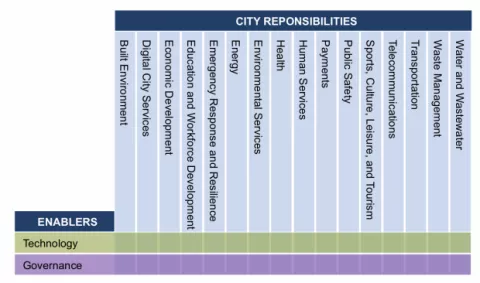
Two horizontal bands labeled “Enablers” cut across all of the columns. We drew it this way to emphasize that these two areas can empower and unleash all of a city’s departments.
That concept is easy to understand when it comes to Technology. If you were to expand the Technology enabler, you would see dozens of individual technologies grouped into three categories: Communications, Computing, and Instrumentation. Let’s use communications as an example. If a city installs a wireless communications network, it empowers all of its departments (even if the network is initially used by only one).
But Governance is equally valuable as a force multiplier. If you were to expand the Governance enabler, you would see these 11 elements:
- Capacity
- Cross-Departmental Framework
- Financing
- Leadership
- Performance Management and Metrics
- Policy
- Process
- Procurement
- Resilience/Sustainability
- Risk Management
- Stakeholder Engagement
To name just one example, a city that improves #3 (Financing) empowers all of its departments to pursue bigger and better smart city projects.
As described below, Edmonton seeks to make things better for all of its departments by taking advantage of #1 (Capacity), #2 (Cross-Departmental Framework), #4 (Leadership), and #7 (Process).
Edmonton’s Readiness Workshop
Edmonton’s October workshop was made possible with sponsorship from Edison Electric Institute, Cisco, Dell EMC, Forescout, Pennoni, and Verizon. More than 150 city, nonprofit, and regional leaders participated. Mayor Don Iveson gave an opening address highlighting Edmonton’s smart city progress over the past few years. Council members Aveva, EY, Forescout, and the IBI Group provided expert insights during the plenary and during the breakout sessions. The Council donated the use of its online collaborative platform, Smart Cities Activator, which was used to gather information before the workshop and during breakout sessions.
In the words of Soumya Ghosh, the city’s Director of Digital Enablement, Edmonton wishes to “focus on how to operationalize smart city behaviors.” By operationalizing, he was referring to:
- Capacity and Process: Integrating ideas and skills from one-time initiatives into the fabric of daily activity
- Leadership: Trigger leadership that is bottom-up instead of top-down
- Process and Cross-Departmental Framework: Developing new processes for the sharing of information and knowledge across departments (known as “silo-busting” in some cities)
I want to emphasize the importance of breaking down silos. Many cities still think in terms of one-off projects serving a single department. But no city can gain full smart city benefits through piecemeal, isolated projects. Instead, they must think in terms of multi-purpose infrastructure that can eventually be used for many functions, even if it initially serves only one department. No city, not even the richest, can afford digital transformation unless it shares technology and costs between departments.
And no city can achieve data-driven insights unless that data flows freely between departments, as Edmonton emphasized during its afternoon breakout sessions.
Edmonton Breakout Sessions
Edmonton’s breakouts focused on transportation, digital city services, and building a safe city for women and girls. The safe city session provided a great example of new behaviors for cross-department collaboration. To date, this initiative has gathered crowd-sourced data about aggressive behavior. The afternoon working group focused on two issues: 1) finding additional data to help focus city interventions and 2) collaborating with other city organizations such as community policing and the Urban Wellness Initiative, both of which have relevant experience and data.
Gathering and analyzing data department by department is certainly a valid way to get started. But cities won’t get the benefits they seek if that data is kept in silos. Only by merging data from multiple sources will they find the correlations, insights, and analytics that can revolutionize city operations. And they can’t reach that goal just by installing new technology. They must also install new behaviors.
Governance has been defined as “the establishment of policies, and continuous monitoring of their proper implementation, by the members of the governing body.” Cities that wish to emulate the progress of Edmonton will do well to look to governance as a powerful way to accelerate their smart city progress.
Philip Bane is the Chief Executive Officer of the Smart Cities Council.



